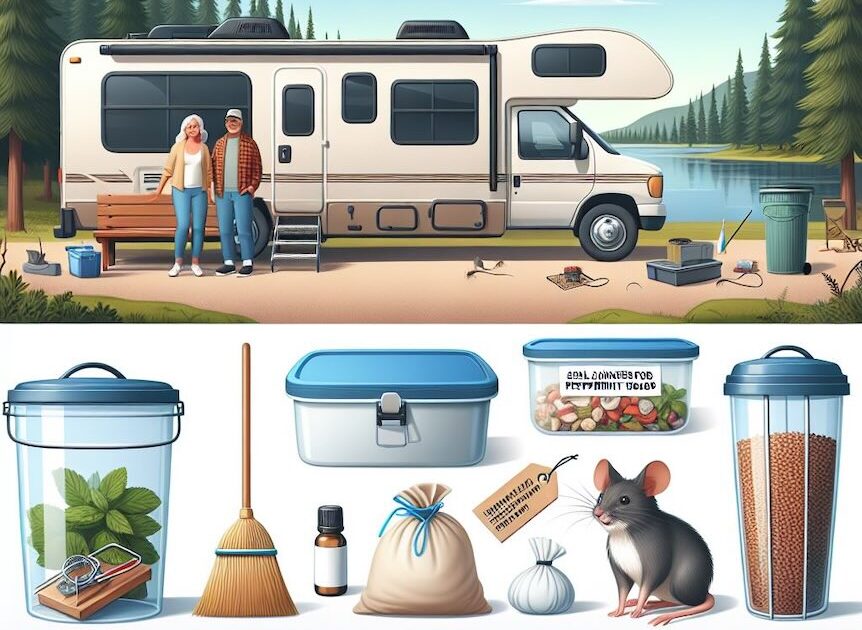Mice can be a real nuisance in an RV, especially when your vehicle is parked or in storage for long periods. These tiny creatures can squeeze into the smallest openings, causing damage to wiring, insulation, and furniture, while also leaving behind unsanitary droppings. Preventing a mouse invasion is essential for maintaining the cleanliness and safety of your RV.
Here’s a comprehensive guide from Custom-way on how to keep mice out of your RV:
1. Seal All Entry Points
Mice can enter through tiny cracks and openings as small as a quarter of an inch. It’s essential to inspect and seal all potential entry points.
- Check under the RV: Inspect the undercarriage for holes around pipes, wiring, or vents. Seal gaps with steel wool, which mice can’t chew through, or use expandable foam to fill the cracks.
- Seal around doors and windows: Ensure all door seals and window screens are intact. Replace any damaged weatherstripping and patch up any torn screens.
- Inspect slide-outs: When extended, slide-outs can leave gaps where mice may enter. Ensure that the seals are tight and in good condition.
2. Use Mouse Deterrents
There are several natural and chemical deterrents you can use to make your RV less appealing to mice.
- Peppermint Oil: Mice dislike the strong smell of peppermint. Soak cotton balls in peppermint oil and place them near potential entry points or areas where mice may enter, such as in cabinets or near wiring.
- Dryer Sheets: Strongly scented dryer sheets can help deter mice as well. Place them in storage compartments, under furniture, and in cupboards. Replace them regularly as their scent fades.
- Cayenne Pepper or Mothballs: Sprinkle cayenne pepper around your RV or use mothballs in storage areas. Both have strong scents that mice avoid. Just be cautious with mothballs, as they contain chemicals that could be harmful to pets or children.
- Ultrasonic Repellent Devices: These devices emit high-frequency sounds that irritate rodents but are inaudible to humans. Plug them into your RV’s outlets, especially near potential entry points.
3. Store Food Properly
Mice are attracted to food, so eliminating access to food sources inside your RV is critical.
- Use airtight containers: Store all food, including pet food, in airtight containers that mice can’t chew through. Avoid leaving open boxes or bags in your cupboards.
- Clean thoroughly: Keep your RV clean by vacuuming regularly, wiping down surfaces, and ensuring that there are no crumbs or spills left unattended.
- Take out the trash: Never leave trash sitting in your RV overnight. Empty garbage bins frequently and use bins with tightly sealed lids.
4. Set Traps for Added Security
If you’re concerned that mice may already be inside your RV, traps can help you catch them before they cause damage.
- Snap Traps: Traditional snap traps can be highly effective if placed in high-traffic areas for mice, such as near baseboards, under furniture, or along walls.
- Live Traps: If you prefer a more humane approach, live traps capture mice without killing them. You can then release the captured mice far away from your RV.
- Bait: Use peanut butter, which is more effective than cheese, as bait in your traps. Be sure to place the traps in strategic locations where you’ve seen signs of mice activity.
5. Elevate and Cover RV Tires
Mice can easily climb RV tires to reach potential entry points. To prevent this, take a few extra precautions:
- Use wheel covers: Invest in quality wheel covers that block access to the tires and prevent mice from climbing them.
- Raise the RV: When storing your RV for long periods, elevate it slightly off the ground. This will make it harder for mice to climb aboard.
6. Regular Maintenance and Inspections
Routine inspections and maintenance are key to preventing mice from sneaking into your RV.
- Inspect regularly: Check your RV for any signs of rodents, such as droppings, gnawed wires, or food wrappers. The sooner you spot a problem, the easier it is to deal with it before it becomes an infestation.
- Maintain your RV’s seals: Replace worn-out door seals, window screens, or weatherstripping as part of your regular RV maintenance routine. Even a small gap can invite unwanted pests.
7. Store Your RV Properly
Where and how you store your RV can impact its vulnerability to rodents.
- Store in a rodent-proof facility: If possible, store your RV in an enclosed, rodent-free facility during the off-season. Make sure it’s clean and sealed tightly.
- Avoid parking near tall grass or woodpiles: Mice and other rodents love hiding in tall grass, woodpiles, or cluttered areas. If you must store your RV outside, park it on concrete or gravel and keep the surrounding area clear.
Signs of Mice in Your RV:
- Droppings in cabinets, drawers, or around food areas.
- Chewed wires, insulation, or fabric.
- Gnaw marks on wood, plastic, or rubber.
- Scratching noises at night, especially in the walls or under furniture.
If you notice any of these signs, act quickly to set traps and block entry points.
At Custom-way, we know that keeping your RV free of pests is vital for a safe and comfortable trip. If you suspect mice in your RV, our professional RV technicians can help with inspection, cleaning, and repairs. Let us help you maintain a pest-free environment, whether you’re storing your RV or out on the road.
Contact Custom-way today to schedule a thorough RV inspection or to learn more about how to protect your RV from rodents and other pests. Safe travels!

